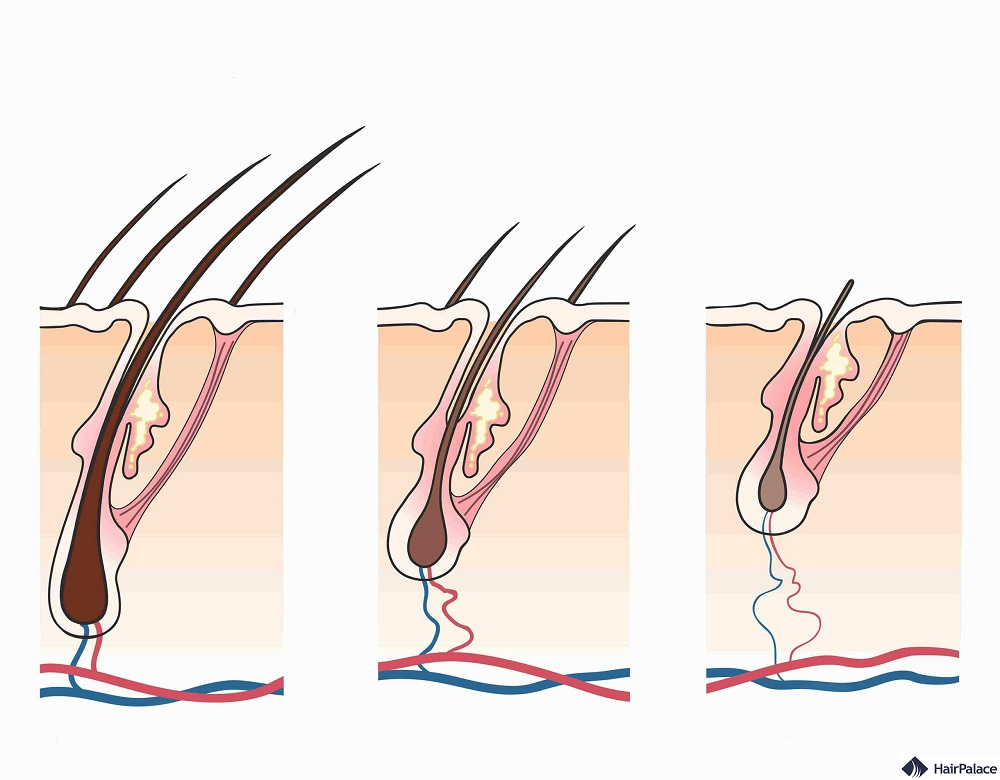Baldness Cure: Does it exist?

Baldness has been a source of concern, often leading to decreased self-esteem and social anxiety for those affected.
Traditional remedies, ranging from over-the-counter topical treatments to surgical options like hair transplants, have provided varying degrees of success.
However, recent scientific developments promise a new era in the quest to find a hair loss cure.
We will uncover the mechanisms behind these innovative treatments, examine their effectiveness, and discuss the potential they hold.
Find out all you need to know about the latest developments in treating baldness!
- Is there a cure for baldness?
- Is a new cure on the horizon?
- Why is there no cure yet?
- Other hair loss treatments
- Conclusion
Is there a cure for baldness?
There is currently no definitive cure for baldness.
One study found that there might be as many as 200 genetic elements that contribute to hereditary hair loss.
In January of last year, a breakthrough was made in a research paper that claimed to have discovered “cavemen genes”.
These genes may explain why humans became hairless while most mammals maintain high hair density on their bodies.
The research wasn’t aimed at finding a cure for male hair loss, its purpose was to better understand human hair.
However, further research in this area might be the key to coming up with a cure for losing hair.
Is a new cure for baldness on the horizon?
While it’s unlikely that we will discover a hair loss treatment that can be used as a fail-proof cure for male and female pattern hair loss.
There are already several solutions in development to potentially resolve the issue of bald patches.
Hair cloning
Scientists established that baldness most likely has its origins in the loss of specialized skin cells known as dermal papillae.
These are cells found within the base of the hair follicle.
It’s believed that these cells play a major role in the regulation of hair thickness, hair growth and texture.
In certain men who are predisposed to male pattern baldness, these cells are killed off by the DHT hormone.
This process can lead to slow hair loss which we know as male and female pattern baldness.
A new approach to hair regrowth aims to reverse the miniaturization caused by DHT by extracting around 100 healthy hair follicles while the patient is still young.
After the extraction of these hairs, they are placed in a container with sub-100C temperatures.
This allows scientists to store the hairs in perfect condition and then access them as required.
Once accessed, the hair can be thawed and scientists can clone new dermal papilla cells.
This way they are able to create a nearly endless supply.
This treatment offers hope to those who are aware of their family history of baldness.
Giving them a chance to regain their hair once their condition has run its course.
Stem cells
Stem cell therapy is being explored as a potential treatment for hair loss.
Researchers are investigating the use of stem cells like mesenchymal stem cells and adipose-derived stem cells to stimulate hair growth by releasing growth factors.
While promising, stem cell therapy for hair loss is still in the experimental stage, and more research is needed to establish its safety and efficacy.
However, a recent breakthrough discovered that a single protein known as TGF-beta has a major role in both follicle development and follicle death.
If we were able to narrow down the mechanisms behind how this protein causes cell division, it might be possible to activate follicle stem cells at will and tackle baldness with their help.
RNA particles
RNA particles are also connected to stem cell research.
One study may have found a way to grow hair by softening stem cells and boosting the production of a certain RNA particle (miR-205) which can ease the stiffness of cells.
Once scientists came up with a way to manipulate stem cells into producing more miR-205, this brought positive effects and resulted in new hairs.
The only downside is that the research was done on mice, so it’s unknown whether it’s effective for stimulating hair growth in humans.
Why is there no definitive cure for male pattern baldness yet?

The absence of a definitive cure for male pattern baldness, or androgenetic alopecia, is due to several complex factors:
Genetic Complexity
Male pattern baldness is largely genetic, and the genetics of hair loss are complex.
It’s not caused by a single gene, but rather by multiple genes, and the way these genes interact with each other can vary greatly among individuals.
This complexity makes it challenging to find a one-size-fits-all treatment to prevent hair loss.
Hormonal Factors
Baldness is closely linked to the presence and actions of androgens, particularly dihydrotestosterone (DHT).
While some treatments reduce the effects of DHT, completely blocking this hormone can have significant side effects, as androgens play important roles in body functions beyond hair growth.
Hair Follicle Miniaturization
In male pattern baldness, hair follicles gradually miniaturize and produce thinner, shorter, and less pigmented hair.
Once a follicle has miniaturized to a certain point, it’s nearly impossible to reverse the process.
Individual Variability
The pattern and progression of hair loss vary widely among individuals, making it difficult to develop a universal treatment that is effective for everyone.
Safety and Side Effects
The scalp and hair follicles are part of a complex biological system. Treatments that affect hair growth can have wide-ranging impacts on other body systems.
Therefore any potential cure must be thoroughly tested for safety and side effects.
Research and Development Challenges
Developing new medical treatments is a time-consuming and costly process, requiring extensive research, clinical trials, and regulatory approvals.
Despite these challenges, research continues in various areas such as stem cell therapy, gene editing, and new pharmacological approaches.
What other treatments for hair loss are available?
While there is no way to cure baldness, there are many options that can halt or even reverse hair loss.
Hair loss treatments vary depending on the cause and severity of the condition. Here are some common treatments for hair loss:
- Minoxidil (Rogaine): Minoxidil is an over-the-counter topical medication that is applied directly to the scalp.
- Finasteride (Propecia): Finasteride is a prescription medication taken orally. It aims to reduce the production of DHT which can often stop the progression of male pattern baldness.
- Hair Transplant Surgery: Procedures like FUE hair transplants remove hair follicles from one part of the body (usually the back or sides of the head) and transplanting them to areas with thinning or no hair.
- Platelet-Rich Plasma (PRP) Therapy: PRP therapy starts by drawing a small amount of blood from the patient, which is then put into a centrifuge to separate the platelets. This platelet-rich plasma is then injected into the scalp in an attempt to stimulate hair growth and strengthen the existing hairs.
- Low-Level Laser Therapy (LLLT): LLLT uses specialized devices, such as laser combs or helmets, to irradiate the scalp with low-level laser light.
- Topical Corticosteroids: Topical corticosteroid creams or ointments may be prescribed to treat certain types of hair loss, such as alopecia areata or inflammation-related hair loss conditions.
- Hair Growth Supplements: Nutritional supplements containing vitamins, minerals, and amino acids, such as biotin, zinc, and iron, are sometimes recommended to support hair health and growth.
- Lifestyle Changes: Making changes to your diet, reducing stress, and adopting a healthier lifestyle can have a positive impact on your overall health and potentially help with hair loss prevention.
Conclusion
Sadly there is no cure for pattern hair loss yet.
However, scientists are working tirelessly to find a permanent cure for hair thinning and hair loss.
From experimenting with stem cell therapy to cloning hair follicles we are getting closer to finding a solution with each passing day.
Finding the best hair loss treatment can be challenging but there are already ways to treat baldness and prevent further hair loss.
If you’re concerned about your condition, visit a medical professional who can advise you on the appropriate treatment options.
Last medically reviewed on June 10th, 2024
- ISHRS Practice Census REsults 2022https://ishrs.org/wp-content/uploads/2022/04/Report-2022-ISHRS-Practice-Census_04-19-22-FINAL.pdf
- Hamilton JB. Patterned loos of hair in man: types and incidence. Annals of the New York Academy of Sciences. 1951;53(3):708–28.https://pubmed.ncbi.nlm.nih.gov/14819896
- Falto-Aizpurua L, Choudhary S, Tosti A. Emerging treatments in alopecia. Expert Opinion on Emerging Drugs 2014; 19: 545–556.https://pubmed.ncbi.nlm.nih.gov/25330928
- Leirós GJ, Attorresi AI, Balañá ME. Hair follicle stem cell differentiation is inhibited through cross-talk between Wnt/β-catenin and androgen signalling in dermal papilla cells from patients with androgenetic alopecia. Br J Dermatol 2012; 166: 1035–1042. https://pubmed.ncbi.nlm.nih.gov/22283397
- Pawitan JA. Prospect of Stem Cell Conditioned Medium in Regenerative Medicine. BioMed Research International 2014; 2014: 965849https://pubmed.ncbi.nlm.nih.gov/25530971
- Zhou L, Wang H, Jing J, Yu L, Wu X, Lu Z. Regulation of hair follicle development by exosomes derived from dermal papilla cells. Biochem Biophys Res Commun 2018; 500: 325–332.https://pubmed.ncbi.nlm.nih.gov/29654758


